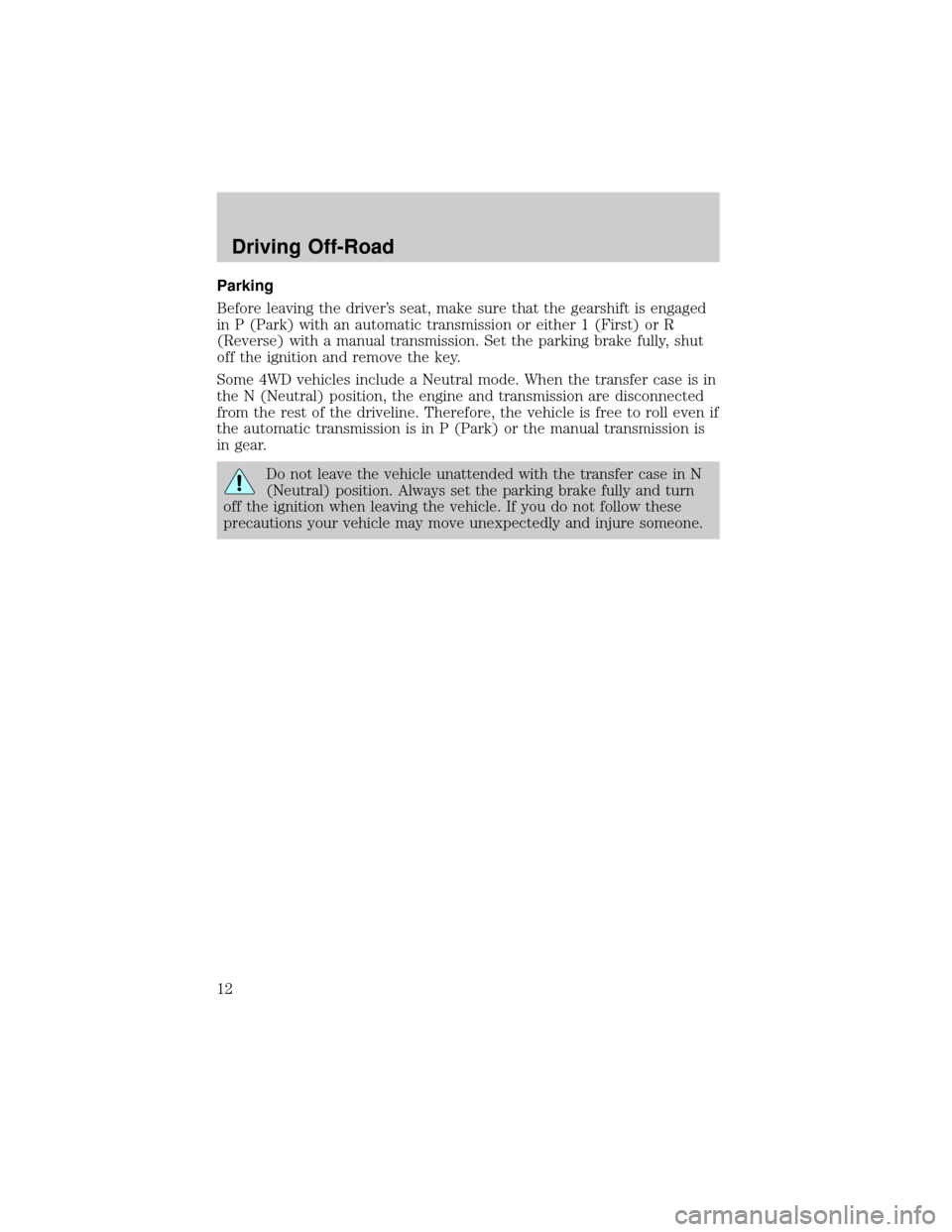ignition Mercury Mountaineer 2007 Manual de Usuario (in Spanish)
[x] Cancel search | Manufacturer: MERCURY, Model Year: 2007, Model line: Mountaineer, Model: Mercury Mountaineer 2007Pages: 48, tamaño PDF: 0.37 MB
Page 32 of 48

²For vehicles with anti-lock brakes, apply and hold the brake firmly. Do
not ªpumpº the brakes. During hard stopping or stopping on slippery
surfaces, you may feel or hear a pulsing or vibration in the brake
pedal. Do not be alarmed because this is your anti-lock brake system
working. See your ªOwner's Guideº for additional information on the
operation of the anti-lock brake system.
Parking
Before leaving the driver's seat, make sure that the gearshift is engaged
in P (Park) with an automatic transmission or either 1 (First) or R
(Reverse) with a manual transmission. Set the parking brake fully, shut
off the ignition and remove the key.
Some 4WD vehicles include a Neutral mode. When the transfer case is in
the N (Neutral) position, the engine and transmission are disconnected
from the rest of the driveline. Therefore, the vehicle is free to roll even if
the automatic transmission is in P (Park) or the manual transmission is
in gear.
Do not leave the vehicle unattended with the transfer case in N
(Neutral) position. Always set the parking brake fully and turn
off the ignition when leaving the vehicle. If you do not follow these
precautions your vehicle may move unexpectedly and injure someone.
Driving On Roadways
8
Page 34 of 48

Driving in mud
Be cautious of sudden changes in vehicle speed or direction when you
are driving in mud. Even 4WD and AWD vehicles can lose traction in
slick mud. As when you are driving over sand, apply the accelerator
slowly and avoid spinning your wheels. If the rear end of the vehicle
does slide while cornering, steer in the direction of the slide until you
regain control of the vehicle.
After driving through mud, clean off residue stuck to rotating tires,
wheels and driveshafts. Excess mud stuck on tires, wheels and rotating
driveshafts causes an imbalance that could damage vehicle components.
Driving through water
Before driving through water,
determine the depth. Avoid water
higher than the center of the wheel
or hubcap. Proceed slowly to avoid
splashing; if the ignition system gets
wet, the vehicle may stall.
Once through water, always try the
brakes. Wet brakes do not stop the
vehicle as effectively as dry brakes. You can dry the brakes faster by
driving the vehicle slowly while applying light pressure on the brake
pedal.
Driving in deep snow
4WD and AWD vehicles are unique in that they can be driven in deep
snow that would stop a conventional two-wheel drive vehicle. Shift to a
low gear and maintain steady pressure on the accelerator. This will help
prevent spinning the wheels while maintaining sufficient momentum to
keep from bogging down. Using tire chains will also help.
Never drive with chains on the front tires of 4WD or AWD vehicles
without also putting them on the rear tires. This could cause the rear of
the vehicle to slide and swing around.
Driving on hills
Operating your vehicle off-road on slopes or hills requires safe
off-road driving practices. Read and follow these safe off-road
driving practices to reduce the risk of loss of vehicle control, vehicle
rollover, serious injury or death.
Driving Off-Road
10
Page 36 of 48

Parking
Before leaving the driver's seat, make sure that the gearshift is engaged
in P (Park) with an automatic transmission or either 1 (First) or R
(Reverse) with a manual transmission. Set the parking brake fully, shut
off the ignition and remove the key.
Some 4WD vehicles include a Neutral mode. When the transfer case is in
the N (Neutral) position, the engine and transmission are disconnected
from the rest of the driveline. Therefore, the vehicle is free to roll even if
the automatic transmission is in P (Park) or the manual transmission is
in gear.
Do not leave the vehicle unattended with the transfer case in N
(Neutral) position. Always set the parking brake fully and turn
off the ignition when leaving the vehicle. If you do not follow these
precautions your vehicle may move unexpectedly and injure someone.
Driving Off-Road
12